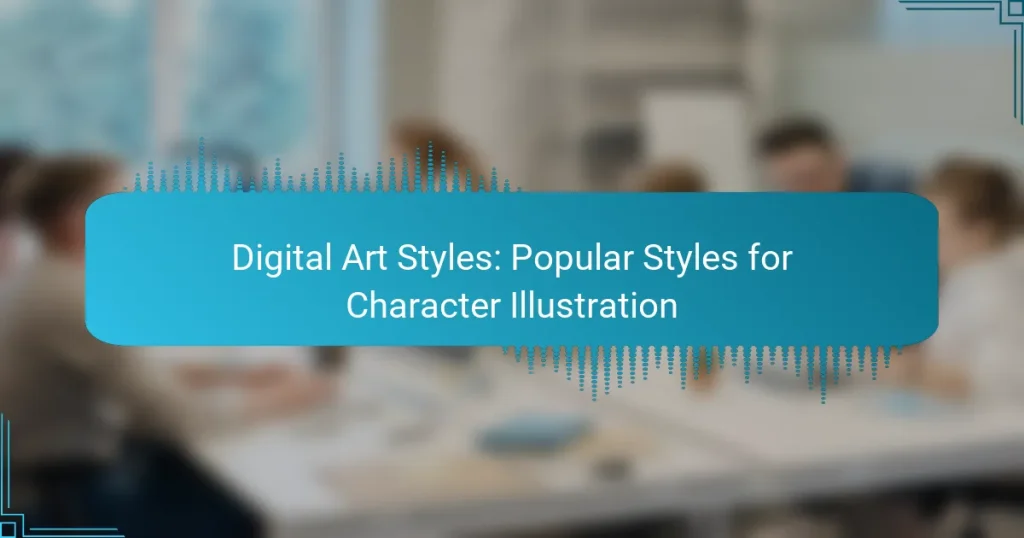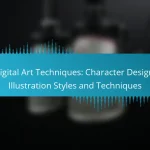Digital art styles for character illustration are diverse and cater to various artistic preferences, with popular options including Anime, Realism, Cartoon, Pixel Art, and 3D Rendering. Selecting the right style is crucial, as it enhances character appeal and aligns with your project’s goals and audience. Understanding the unique characteristics of each style, along with the tools available, can significantly impact the success of your illustrations.
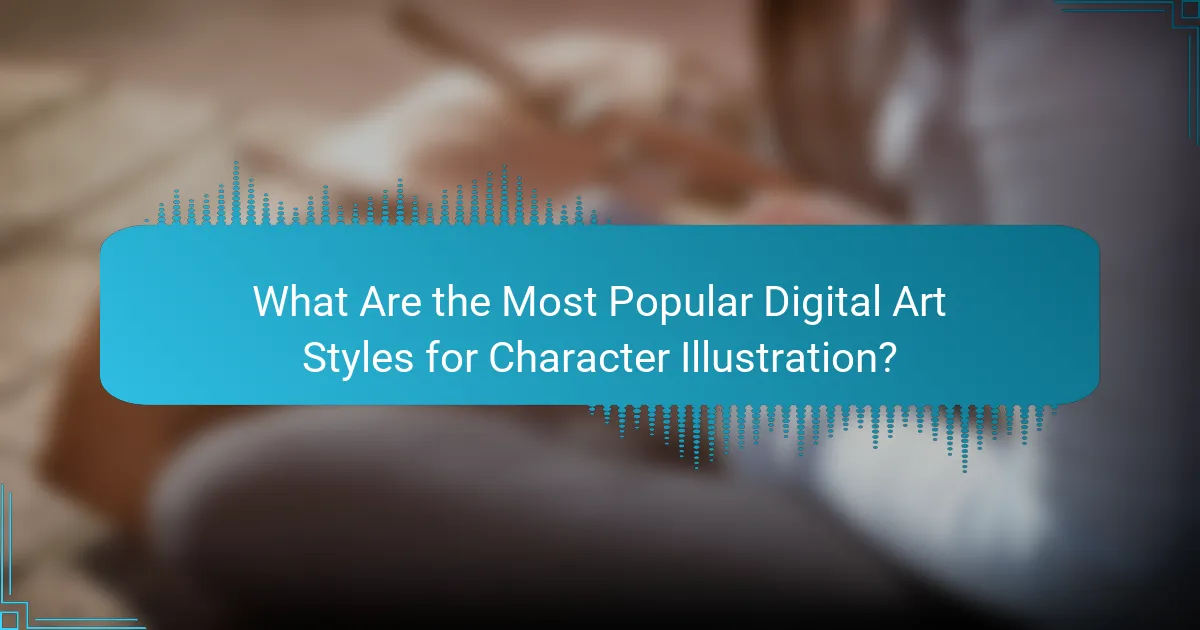
What Are the Most Popular Digital Art Styles for Character Illustration?
The most popular digital art styles for character illustration include Anime, Realism, Cartoon, Pixel Art, and 3D Rendering. Each style has unique characteristics and techniques that cater to different artistic preferences and project requirements.
Anime Style
Anime style is characterized by vibrant colors, exaggerated facial expressions, and distinctively styled hair. This style often features large, expressive eyes and dynamic poses, making it popular for character illustrations in manga and animated series.
When creating anime characters, consider using clean lines and a limited color palette to maintain a cohesive look. Familiarize yourself with common tropes and themes in anime to enhance your character’s appeal.
Realism
Realism aims to depict characters as accurately as possible, focusing on lifelike proportions, textures, and lighting. This style often requires a deep understanding of anatomy and perspective to create believable characters.
To achieve realism, study reference images and practice drawing from life. Pay attention to details like skin texture and lighting effects, as these elements significantly impact the overall realism of your illustration.
Cartoon Style
Cartoon style is defined by its simplified forms, exaggerated features, and playful colors. This style often emphasizes humor and personality, making it suitable for children’s media and lighthearted projects.
When illustrating in a cartoon style, focus on bold outlines and vibrant colors. Experiment with proportions and expressions to convey emotions effectively, and consider using a limited color palette for a cohesive look.
Pixel Art
Pixel art is a digital art form that uses small squares of color to create images, reminiscent of early video games. This style is known for its retro aesthetic and is often used in indie games and mobile applications.
To create pixel art characters, work within a restricted color palette and grid system. Start with a small canvas size to maintain clarity and detail, and use dithering techniques to create shading and texture.
3D Rendering
3D rendering involves creating characters in a three-dimensional space, allowing for realistic lighting and depth. This style is widely used in video games, animations, and virtual reality applications.
When working with 3D rendering, familiarize yourself with modeling software like Blender or Maya. Pay attention to texturing and rigging to ensure your characters move naturally. Consider the balance between detail and performance, especially for real-time applications.
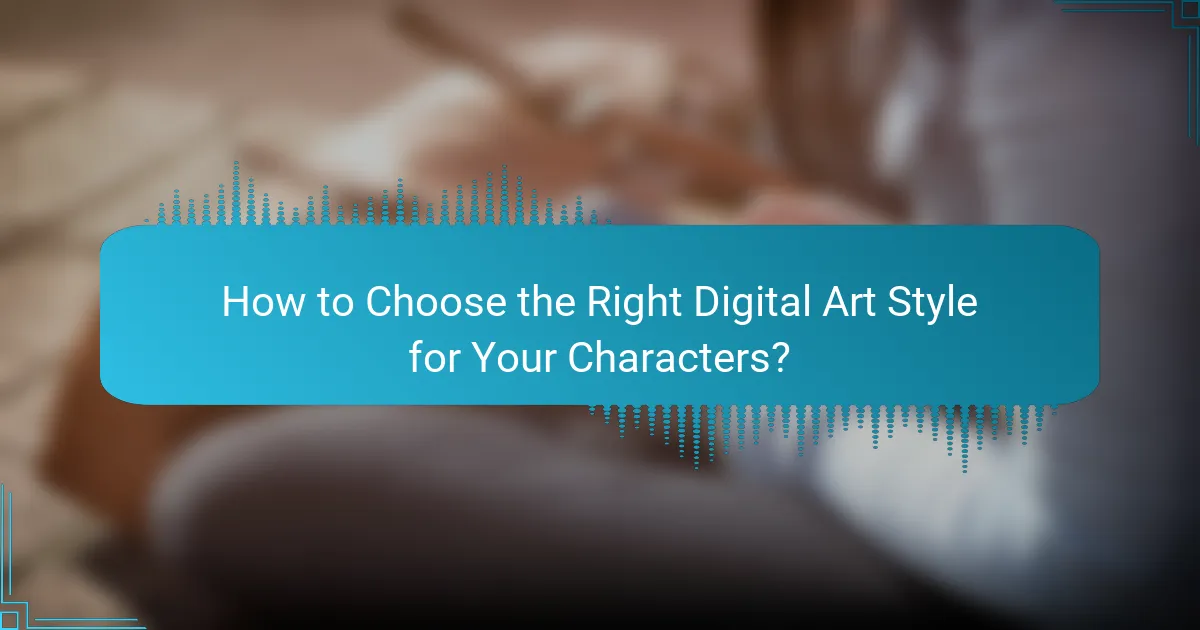
How to Choose the Right Digital Art Style for Your Characters?
Choosing the right digital art style for your characters involves understanding your audience, project goals, and the tools at your disposal. A well-suited style enhances character appeal and aligns with the intended message or theme.
Consider Your Target Audience
Your target audience significantly influences the digital art style you should choose. For example, styles that appeal to children, like cartoonish and vibrant designs, differ from those aimed at adults, which may lean towards realism or more sophisticated aesthetics.
Conducting audience research can help identify preferences. Consider age, interests, and cultural backgrounds to select a style that resonates well with your viewers.
Evaluate Project Goals
Understanding your project goals is crucial in selecting a digital art style. If your aim is to convey a lighthearted story, a whimsical or exaggerated style may be appropriate. Conversely, for a serious narrative, a more realistic or subdued style might be better.
Define your project’s objectives clearly. Are you looking to evoke emotions, tell a story, or promote a product? Aligning your art style with these goals will enhance the overall effectiveness of your characters.
Assess Available Tools
The tools you have access to can limit or expand your choices for digital art styles. Familiarity with software like Adobe Photoshop, Procreate, or Clip Studio Paint can influence the complexity and type of style you can achieve.
Consider the capabilities of your hardware as well. High-performance tablets and computers can handle more detailed styles, while basic devices may restrict you to simpler designs. Always choose a style that matches both your skill level and the tools available to you.

What Tools Are Best for Creating Character Illustrations?
Several tools stand out for creating character illustrations, each offering unique features and workflows. The best choice depends on your specific needs, such as budget, preferred style, and device compatibility.
Adobe Photoshop
Adobe Photoshop is a versatile tool widely used for character illustration due to its powerful features and extensive brush library. It supports both raster and vector graphics, allowing artists to create detailed and high-quality images.
When using Photoshop, consider leveraging layers for complex illustrations, as they enable easy adjustments and edits. The software is subscription-based, with plans starting around $20 per month, making it accessible for both beginners and professionals.
Procreate
Procreate is a popular choice among digital artists, especially for those using iPads. Its intuitive interface and robust brush engine make it ideal for sketching and painting character illustrations on-the-go.
Procreate offers a one-time purchase price of approximately $10, providing excellent value for its features. Artists can benefit from customizable brushes and a streamlined workflow, making it easy to create and refine character designs quickly.
Clip Studio Paint
Clip Studio Paint is tailored for comic and character artists, offering specialized tools for inking and coloring. Its vector capabilities allow for smooth scaling without loss of quality, which is beneficial for detailed character work.
This software is available through a one-time purchase or a subscription model, typically costing around $50 to $200, depending on the version. Users appreciate its extensive asset library and the ability to create animations, adding versatility to character illustration projects.
Corel Painter
Corel Painter is known for its realistic brush simulation, making it a favorite among traditional artists transitioning to digital. It offers a wide range of brushes that mimic real-world media, ideal for creating textured character illustrations.
Corel Painter operates on a one-time purchase basis, generally priced around $400, which may be a consideration for budget-conscious artists. The software is particularly effective for those who prioritize a painterly style in their character designs.
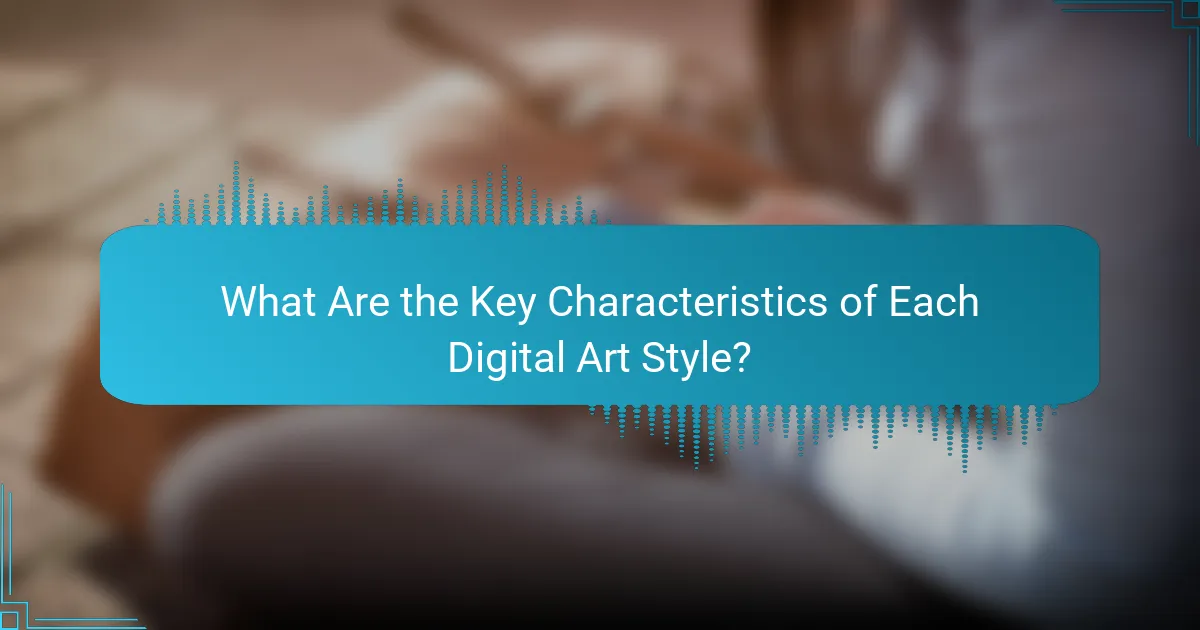
What Are the Key Characteristics of Each Digital Art Style?
Digital art styles vary significantly in their visual elements and techniques, each offering unique characteristics that define the overall aesthetic. Understanding these key traits helps artists choose the right style for their character illustrations.
Anime Style Features
Anime style is characterized by vibrant colors, exaggerated facial expressions, and distinct character designs. Common features include large, expressive eyes, sharp lines, and dynamic poses that convey movement and emotion.
When creating anime characters, consider using a limited color palette for skin tones and hair, focusing on bold contrasts to enhance visual impact. Pay attention to the proportions, often featuring elongated limbs and stylized features to achieve that signature look.
Realism Characteristics
Realism in digital art aims to depict subjects as accurately as possible, capturing details and textures that resemble real life. This style often involves careful attention to lighting, shading, and anatomy to create lifelike representations.
To achieve realism, artists should study human anatomy and observe how light interacts with different surfaces. Utilizing high-resolution textures and employing techniques like layering can enhance the depth and realism of character illustrations.
Cartoon Style Traits
Cartoon style is defined by simplified shapes, bold outlines, and exaggerated features, often emphasizing humor and personality. Characters typically have oversized heads and smaller bodies, allowing for expressive facial features and playful designs.
When illustrating in a cartoon style, focus on creating clear silhouettes and using bright, saturated colors. Keep details minimal to maintain a clean look, and consider incorporating whimsical elements to enhance the character’s charm and appeal.

What Are the Trends in Digital Character Illustration?
Current trends in digital character illustration emphasize innovation and creativity, blending traditional techniques with modern technology. Artists are increasingly exploring hybrid styles, utilizing AI tools, and focusing on diversity and inclusion to create compelling and relatable characters.
Hybrid Styles
Hybrid styles in digital character illustration combine various artistic techniques and influences, resulting in unique visual expressions. For instance, an artist might merge elements of realism with cartoonish features, creating a distinctive look that appeals to a broad audience.
When adopting hybrid styles, consider the balance between different elements to maintain coherence. Experimenting with color palettes and textures can enhance the overall aesthetic, making characters more engaging. Artists often find inspiration in diverse genres, from anime to Western comics, to develop their hybrid approach.
Incorporating AI Tools
AI tools are becoming integral to digital character illustration, assisting artists in streamlining their workflow and enhancing creativity. These tools can generate initial sketches, suggest color schemes, or even automate repetitive tasks, allowing artists to focus on the creative aspects of their work.
While using AI, it’s essential to maintain a personal touch in your illustrations. Relying too heavily on automated processes can lead to a loss of individuality in your art. Aim to use AI as a supportive tool rather than a replacement for your unique artistic vision.
Focus on Diversity and Inclusion
There is a growing emphasis on diversity and inclusion in digital character illustration, reflecting a broader societal shift towards representation. Artists are increasingly creating characters that represent various ethnicities, body types, and backgrounds, making their work more relatable and impactful.
To effectively incorporate diversity, research and understand the cultures you wish to represent. Avoid stereotypes and strive for authenticity in character design. Engaging with communities and seeking feedback can help ensure that your illustrations resonate positively with diverse audiences.
